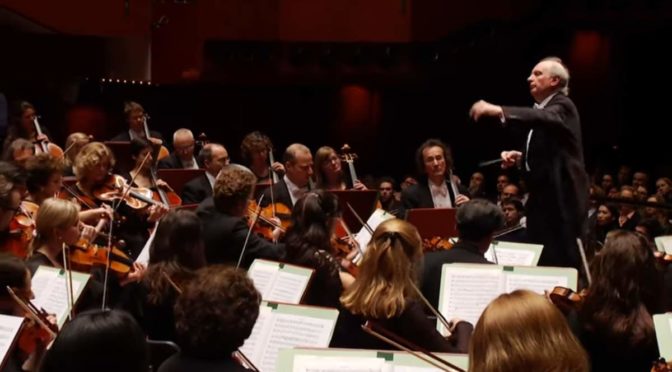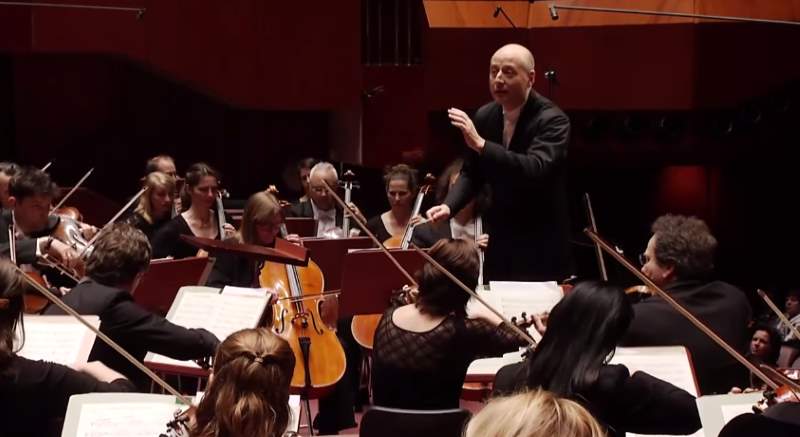Conducted by Marek Janowski, the hr-Sinfonieorchester (Frankfurt Radio Symphony Orchestra) performs Robert Schumann’s Symphony No. 3 in E-flat major, Op. 97, also known as the Rhenish. Composed from 2 November to 9 December 1850, it is the last symphony composed by the German romantic era composer. Recorded at Alte Oper Frankfurt on March 4, 2016. Published by hr-Sinfonieorchester.
Schumann was inspired to write the symphony after a trip to the Rhineland (the name used for a loosely defined area of Western Germany along the Rhine River, chiefly its middle section) with his wife Clara. This journey was a happy and peaceful trip, which felt to them as if they were on a pilgrimage. He incorporated elements of the journey and portrayed other experiences from his life in the music.
The piece premiered on 6 February 1851 in Düsseldorf, conducted by the composer himself.

Movements
- Lebhaft The first movement, “Lebhaft” (lively), follows the 19th century model of a large-scale sonata form. The symphony begins immediately with a heroic theme in E-flat major, scored for full orchestra. The strong hemiolic rhythm of the main theme returns throughout the movement giving an ever present forward push. This forward push allows for the melodies of this movement to soar over the bar lines. The transition moves from the tonic to mediant, G minor, with the use of a newly introduced motive in the strings consisting of energetic ascending eighth notes juxtaposed with material from the main theme. The subordinate theme is scored for winds and its less rhythmic drive has a gentler quality. The exposition unfolds with the return of the scale motif from the transition and main theme, ending in the dominant, B-flat. Schumann does not repeat the exposition, but rather has the strings and bassoon drop from unison B-flat to an F-sharp, leading to a triplet forte explosion in the unexpected key of G major marking the beginning of the development. The development section is composed mainly of the three main themes from the exposition. Schumann skilfully moves through a variety of keys for nearly 200 bars, never returning to E-flat, until a dominant arrival preceding the climactic and triumphant return of the main theme in the home key.
- Scherzo: Sehr mäßig (in C major) The second movement, “Sehr mäßig (very moderate), is in C major and takes the place of a Scherzo. The form of this movement is a synthesis of a traditional minuet and trio and theme variations. The opening theme is based on the ländler, a German folk dance. This is played out first in the lower strings and bassoons, and then is repeated and varied. The second theme with “trio” feeling is in A minor, played by the winds. Schumann uses a pedal point C throughout this section which is highly unusual, not because it is a pedal point, but rather because C is the third note instead of the root of A minor. After this middle section the rustic theme returns scored for full orchestra and thins out until only the celli and bassoons are playing the theme, ending with soft pizzicato.
- Nicht schnell (in A-flat major) The third movement, “Nicht schnell” (not fast), is in the subdominant, A-flat major. The omission of timpani and brass in combination with the static harmony (the movement never strays far or for long from A-flat), creates a moment of calm repose in the middle of the symphony. The thematic construction uses long beautiful themes that are constantly being pushed along by this friendly little motif of four chromatically ascending sixteenth notes, often on the fourth beat of a measure.
- Feierlich (in E-flat minor) The Fourth movement, “Feierlich” (solemn), though written with three flats as the key signature, is in E-flat minor. The movement begins with a sforzando eight note E-flat minor chord in the strings that moves immediately into a pianissimo french horn and trombone chorale. This beautiful and hauntingly quiet low brass writing is a notoriously difficult spot in performances since the trombones haven’t played at all up until this point. This expansive theme is voiced by the winds and first violins in eight notes, accelerating the tempo by more than double the previous tempo, as the opening statement reaches its conclusion. Following the opening statement’s conclusion, the theme is used in imitation, mostly at the fourth and fifth, and combined with an accelerated version. After this, the tempo changes into a triple meter where the first theme undergoes a series of contrapuntal treatments. While the meter returns to a duple meter, the brass and winds play interwoven contrapuntal lines of the most expansive form of the theme while the strings push forward with constant 16th notes. This comes to a close on an E-flat minor chord, and after one beat’s rest an unexpected fanfare in B major which is then answered by the string in pianissimo, restating it in E-flat. While this is repeated the rhythmic motion slows down, and fragments of the theme can be heard at the end.
- Lebhaft In the fifth movement, the piece returns to E-flat major in duple meter with the spirited feeling of a Finale. The first theme returns to the rustic dance feel from earlier in the symphony, scored for full orchestra. Sixteen bars later, a second, lighter but just as spirited theme appears. These themes are varied and imitated as the movement pushes exuberantly forward toward its heroic conclusion in E-flat major.
Sources
- Symphony No. 3 (Schumann) on wikipedia

